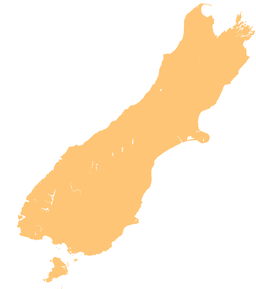geo.wikisort.org - Reservoir
Lake Hāwea is New Zealand's ninth largest lake.
| Lake Hāwea | |
|---|---|
 Lake Hāwea, looking north | |
| Location | Queenstown-Lakes District, Otago Region, South Island |
| Coordinates | 44°30′S 169°17′E |
| Primary inflows | Hunter River |
| Primary outflows | Hāwea River |
| Basin countries | New Zealand |
| Max. length | 35 km (22 mi) |
| Surface area | 141 km2 (54 sq mi) |
| Max. depth | 392 m (1,286 ft) |
| Surface elevation | 348 m (1,142 ft) |
| Islands | Silver Island |
The lake is in the Otago Region at an altitude of 348 metres. It covers 141 km² and reaches 392 metres deep.
Lake Hāwea is named after a Māori tribe who preceded the Waitaha people in the area.[1]
Lake Hāwea stretches 35 kilometres from north to south. It lies in a glacial valley formed during the last ice age, and is fed by the Hunter River. Nearby Lake Wānaka lies in a parallel glacial valley eight kilometres to the west. At their closest point, a rocky ridge called The Neck, the lakes are only 1000 metres apart.

Lake Hāwea is dammed to the south by an ancient terminal moraine created some 10,000 years ago. In 1958 the lake was artificially raised 20 metres to store more water for increased hydroelectric power generation at the Roxburgh Dam.[2]
The only flat land around the lake is at its southern end, surrounding its outflow into the Hāwea River, a short tributary of the Clutha / Matau-au, which it joins near Albert Town. The settlement of Lake Hāwea is found at the lake's southern shore.
The lake is a popular resort, well used in the summer for fishing, boating and swimming. The nearby mountains and fast-flowing rivers allow for adventure tourism year-round, such as jetboating and skiing.
Māori history
For Māori, the Wānaka and Hāwea area was a natural crossroads. The Haast Pass led to the West Coast and its pounamu; the Cardrona Valley led to the natural rock bridge "Whatatorere" which was the only place that the Kawarau River and Clutha River / Mata-Au could be crossed without boats.[1] Mōkihi reed boats enabled a swift return downriver to the east coast.
The Cromwell basin supported a large population of moa, which were hunted to extinction about 500 years ago.[1]
Until the early nineteenth century, the area was visited annually by Ngāi Tahu who sought pounamu in the mountains above the Haast River and hunted eels and birds over summer, returning to the east coast by descending the Clutha River / Mata-Au in reed boats.[3] Ngāi Tahu use of the land was ended by attacks by North Island tribes.[1] In 1836, the Ngati Tama chief Te Puoho led a 100-person war party, armed with muskets, down the West Coast and over the Haast Pass: they fell on the Ngāi Tahu encampment between Lake Wānaka and Lake Hāwea, capturing 10 people and killing and eating two children.[4] Although Te Puoho was later killed by the southern Ngāi Tahu leader Tuhawaiki,[5] Maori seasonal visits to the area ceased.
The first European to see the lake was Nathaniel Chalmers in 1853.[6] Guided by Reko and Kaikoura, he walked from Tuturau (Southland) to the lakes via the Kawarau River. He was stricken by dysentery, so his guides returned him down the Clutha in a reed boat.[7]
Namesakes
There have been three Royal New Zealand Navy ships named after the lake, one of which is still in active service.
See also
- List of lakes in New Zealand
- Lakes of New Zealand
References
- Stephenson, Janet; Bauchop, Heather; Petchey, Peter (2004). Bannockburn Heritage Landscape Study (PDF). p. 29.
- Malcolm McKinnon (2009). "Otago places – Clutha River/Mata-Au". Te Ara – the Encyclopedia of New Zealand. Retrieved 13 July 2017.
- Malcolm McKinnon (2009). "Otago region – Māori history and whaling". Te Ara – the Encyclopedia of New Zealand. Retrieved 11 July 2017.
- S Percy Smith (1910). History and Traditions of the Maoris of the West Coast North Island of New Zealand Prior to 1840. New Plymouth: Polynesian Society.
- Atholl Anderson (1990). "Te Puoho-o-te-rangi". Te Ara – the Encyclopedia of New Zealand. Vol. 1. Retrieved 11 July 2017.
- Jock Phillips (2006). "European exploration – Otago and Southland". Te Ara – the Encyclopedia of New Zealand. Retrieved 11 July 2017.
- Roger Frazer (1990). "Chalmers, Nathanael". Te Ara – the Encyclopedia of New Zealand. Dictionary of New Zealand Biography. Vol. 1. Retrieved 13 July 2017.
Other sources
- Hawea
- Wise's New Zealand guide: A gazetteer of New Zealand (4th ed.) (1969) Dunedin: H. Wise & Co. (N.Z.) Ltd.
- Encyclopædia Britannica. Retrieved February 2006, from Encyclopædia Britannica Premium Service.
На других языках
[de] Lake Hāwea
Der Lake Hāwea ist ein ehemaliger Gletschersee auf der Südinsel von Neuseeland. Der See befindet sich in der Region Otago und wird heute zur Stromgewinnung genutzt.[3]- [en] Lake Hāwea
[fr] Lac Hawea
Le lac Hawea est un lac de l'Île du Sud en Nouvelle-Zélande. Il est drainé ou a pour émissaire la rivière Hawea, qui est un affluent gauche du fleuve la Clutha[1].[ru] Хавеа (озеро)
Хавеа (англ. Lake Hawea) — озеро на острове Южный в Новой Зеландии. Находится на территории региона Отаго, примерно в 293 км к северо-западу от города Данидин.[1] Площадь водосборного бассейна — 1388 км².[источник не указан 1951 день] Высота над уровнем моря — 348 м.[источник не указан 1951 день]Другой контент может иметь иную лицензию. Перед использованием материалов сайта WikiSort.org внимательно изучите правила лицензирования конкретных элементов наполнения сайта.
WikiSort.org - проект по пересортировке и дополнению контента Википедии


